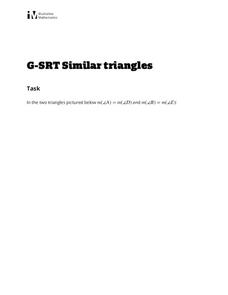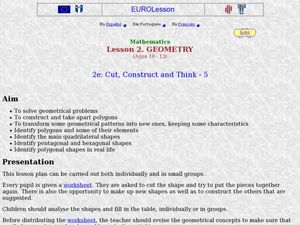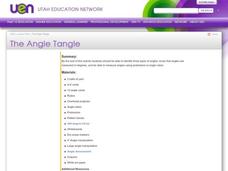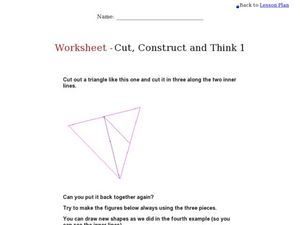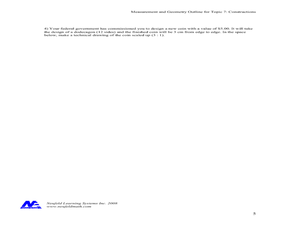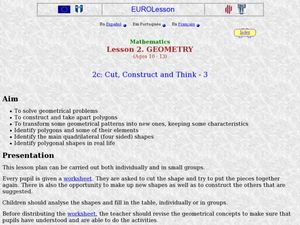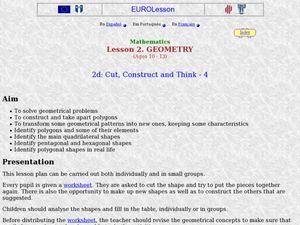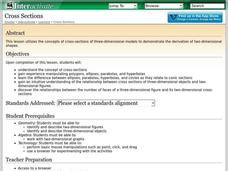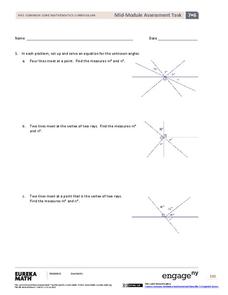Virginia Department of Education
Congruent Triangles
Is this enough to show the two triangles are congruent? Small groups work through different combinations of constructing triangles from congruent parts to determine which combinations create only congruent triangles. Participants use the...
Illustrative Mathematics
Similar Triangles
Proving triangles are similar is often an exercise in applying one of the many theorems young geometers memorize, like the AA similarity criteria. But proving that the criteria themselves are valid from basic principles is a great...
Smithsonian Institution
Geometric Shapes Collage
Junior geometers practice stating the names of different geometric shapes. They define and name the different shapes and compare and contrast shapes to one another. They also relate the shapes to objects in the real world.
Curated OER
Exploration with Geometric Solids
Students reinforce geometric concepts by playing "Guess My Solid." Through a process of elimination, they determine the shapes of mystery solids. Finally, students use various materials to construct their own geometric figures.
Curated OER
Geometry: Cut, Construct, Think
Students identify the properties of polygons. In this geometry lesson, students cut out shapes try to construct polygons. Students analyze the shapes and fill out a table of characteristics.
Texas Instruments
Getting Started with Cabri Jr.
Pupils construct geometric figures using Cabri Jr. in this constructing geometric figures using Cabri Jr. activity. They familiarize themselves with Cabri Jr. and construct segments and triangles. Your learners will use various tools to...
Pennsylvania Department of Education
A Geometric Scavenger Hunt
Fifth graders connect their knowledge of polygons and polyhedrons. For this geometric shapes lesson, 5th graders identify and classify two- and three-dimensional objects. Students construct a polyhedron out of polygons and describe their...
Curated OER
Circles and Parabolas
In this circles and parabolas activity, students follow directions to draw parabolas. They fold paper to represent a parabola. Students also use straight lines to create a circle. This one page activity contains three multi-step...
Curated OER
Bold Bridges
For this science worksheet, students collaborate in performing an investigation regarding the best bridge construction for maximum strength. Students build several designs of bridges out of pins, straws, fishing line, and small Styrofoam...
Curated OER
Make Shapes and Describe Their Features
In this shapes and their features learning exercise, students construct triangles, quadrilaterals, pentagons, hexagons, and heptagons using four designated shapes. In this problem solving learning exercise, students create as many of the...
Curated OER
Angles
Fourth and fifth graders investigate angles and name them according to the criteria for obtuse, acute, and right angles. They examine a human-made yarn pattern on the floor of their classroom and identify angles, vertices, and types of...
Curated OER
Duplicating Segments and Angles
Tenth graders investigate geometric construction. In this geometry lesson, 10th graders explore the procedure for copying an angle and a segment. The lesson emphasizes the difference between a sketch, a drawing, and a...
Curated OER
Triangle Worksheet: Cut, Construct and Think 1
In this triangle worksheet, 6th graders draw and cut out a triangle, cut it into three pieces, then arrange the pieces to make new shapes.
Curated OER
Exploring Geometric Constructions of Parabolas
Students are introduced to the construction geometrically of parabolas. Using a software program, they identify lines, segments and midpoints. They label the parabolas properties and characteristics and use a formula to determine the...
Curated OER
Constructing Geometric Shapes
In this construction geometric shapes worksheet, student use the software program for instruction then construction shapes and bisect angles for four questions.
Curated OER
Cut, Construct and Think 3
Students identify and create shapes. In this geometric shapes lesson, students identify various polygons and try to create new shapes using existing polygons.
Curated OER
Cut, Construct and Think - 4
Students identify polygons. In this geometric shapes lesson, students identify and describe polygons. Students create new shapes out of the shapes they are given.
Shodor Education Foundation
Cross Sections
Use this activity on cross-sections of three-dimensional shapes in your math class to work on algebra or geometry Common Core standards. The lesson includes a list of relevent terminology, and a step-by-step process to illustrate the...
Curated OER
Shape Collages
To reinforce shape recognition and identification, little learners create a shape collage. They name each shape as they go, gluing or pasting them onto bright paper. They discuss collage techniques and are encouraged to use their shapes...
Curated OER
ABC and 1-2-3 Farming
Students demonstrate how to alphabetize animal names. In this word study lesson, students identify animals that live on the farm and conduct a favorite farm animal survey. Students order animal pictures in alphabetical order.
EngageNY
Rotations, Reflections, and Symmetry
Lead your high school class on a journey through the world of symmetry and reflections as you discuss geometric principles. Pupils differentiate between reflections and rotations, explore rotational symmetry, and investigate how to...
EngageNY
Mid-Module Assessment Task: Grade 7 Mathematics Module 6
This is a mid-module assessment for the 16th lesson in 29 geometry lessons. Individuals demonstrate their understanding of concepts such as vertical and adjacent angles, constructing geometric figures, and triangle congruence criteria.
Radford University
Quadrilaterals
Connect the quadrilaterals. Working in teams, pupils use a variety of tasks to make connections between special quadrilaterals. With the properties well defined, the groups construct quadrilaterals based on those properties. Learners...
Curated OER
Principles of Flight: Flying Paper Airplanes
Students investigate ways to enhance an object's flying ability. In this model construction instructional activity, students construct two paper airplanes, one of which is twice as big as the first. Students compare and...

